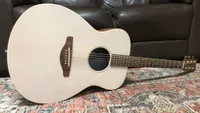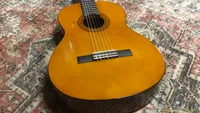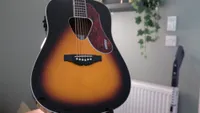Best acoustic guitar for beginners 2025: Strum your first chords with our choice of beginner acoustic guitars
Start playing today with beginner acoustics from Taylor, Fender, Epiphone, Martin and more – hand-picked by experts
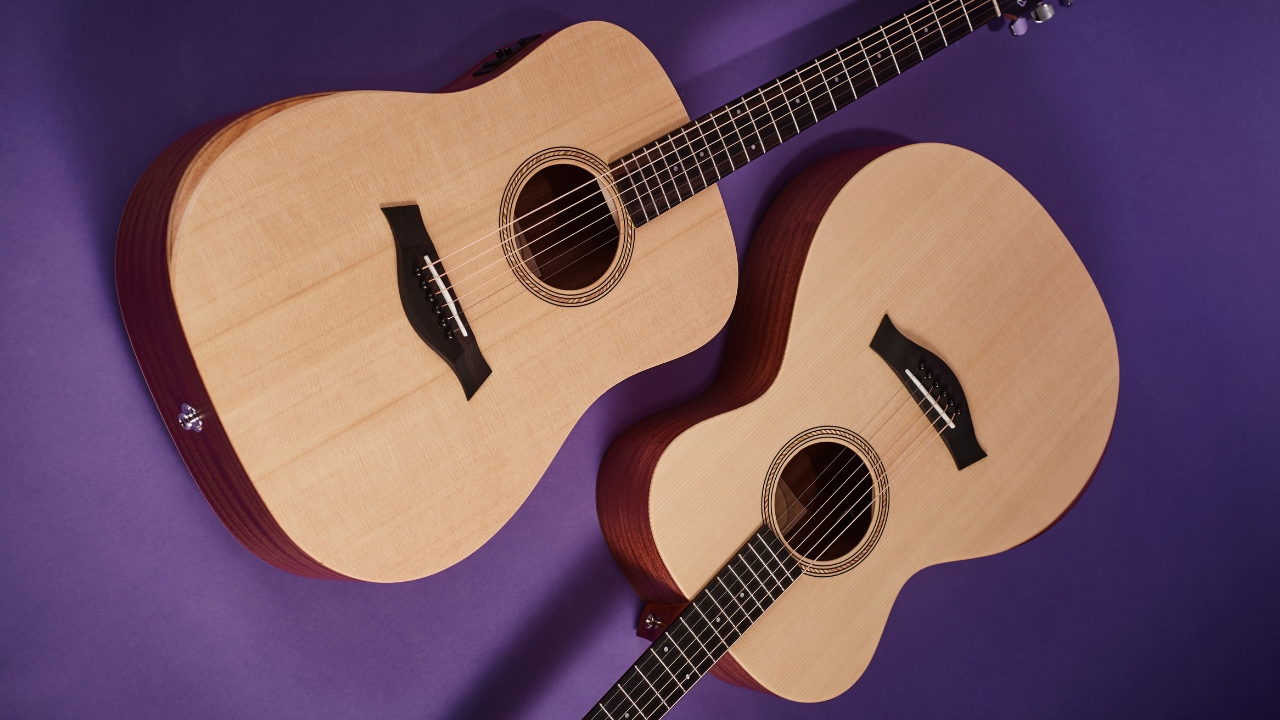
So you’ve finally decided to take the plunge and start learning guitar, or maybe you’re buying for someone who wants to? Whatever it is, to prepare for a lifelong journey of creative fulfilment, you’ll need one of the best acoustic guitars for beginners in your hands. The perfect starting point for those first chords and riffs, an acoustic guitar will set you up for success and years of fun, providing the springboard to launch your guitar-playing career.
An acoustic guitar is a fantastic starting point for any budding guitarist. Countless players have developed their skills by beginning on an acoustic. Compared to an electric guitar, acoustics can be a bit more challenging due to thicker strings and larger body sizes, but don’t let that put you off. I believe this tougher starting point builds finger strength and develops better technique. Once you get past the initial hurdle of learning those first few chords, your progress will skyrocket.
Currently, my top choice is the Taylor Academy 10. To me, this guitar is ultra-playable and has a bright, clean tone that can't be beaten at this price point. If you are on a tighter budget, I'd recommend the Fender CD60S. This affordable dreadought offers serious bang for your buck.
Now, if you’re buying for the first time and have some questions, make sure to check out our comprehensive FAQs section, which features everything you need to know about beginner acoustics, written by experts who test gear and play for a living. If you want to get straight to our top choices, keep scrolling.
Our top picks
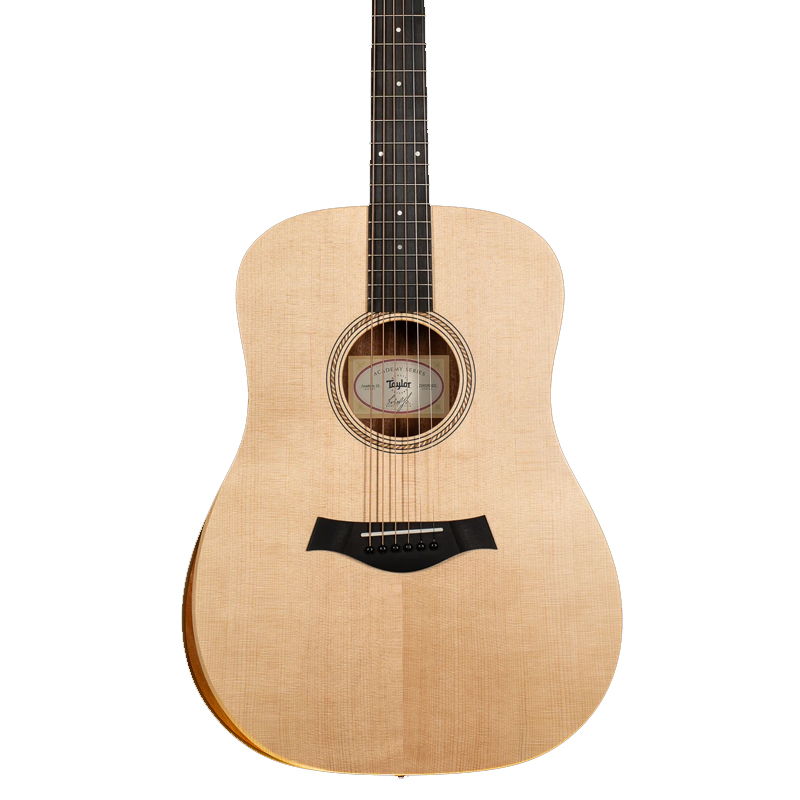
As one of the acoustic world’s ‘big two’, Taylor Guitars has a long track record of producing some of the highest quality, best sounding acoustic guitars around. Recently, however, it made a conscious decision to appeal to the beginner guitarist, and the Taylor Academy 10 is the culmination of this. While the price may put it slightly out of reach of anyone only half-heartedly interested in learning, for those who are committed this guitar represents incredible value.
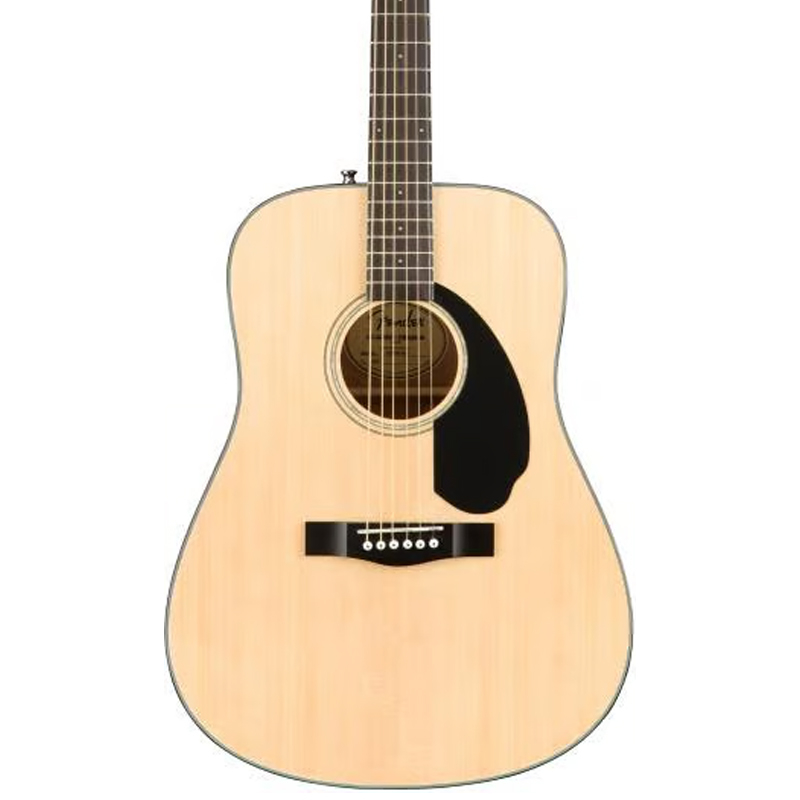
The Fender CD-60S is a great value, entry-level warm welcome of an acoustic guitar. We particularly like its neck, with its rolled fingerboard edges ensuring it is easy to pull off barre chords and the like. The solid spruce top is a nice feature which adds some depth of tone beginner guitars are often devoid of. The large dreadnought body projects a boomy voice which will be pleasing as you start to make sense of those aforementioned barre chords.
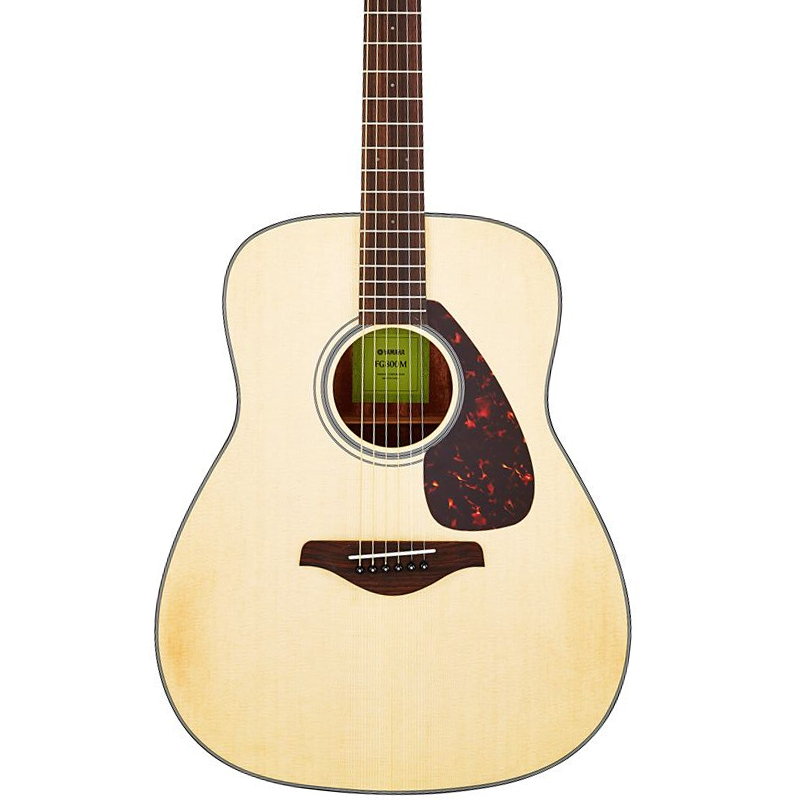
The most surprising feature of the FG800 is the inclusion of a solid top – not something you usually find on a guitar at this price point. This allows the guitar to resonate freely, creating a fuller, warmer tone. Underneath the solid top lies Yamaha’s new scalloped bracing which results in plenty of volume and power. The large Dreadnought body accumulates all these features to produce a lovely, big tone.
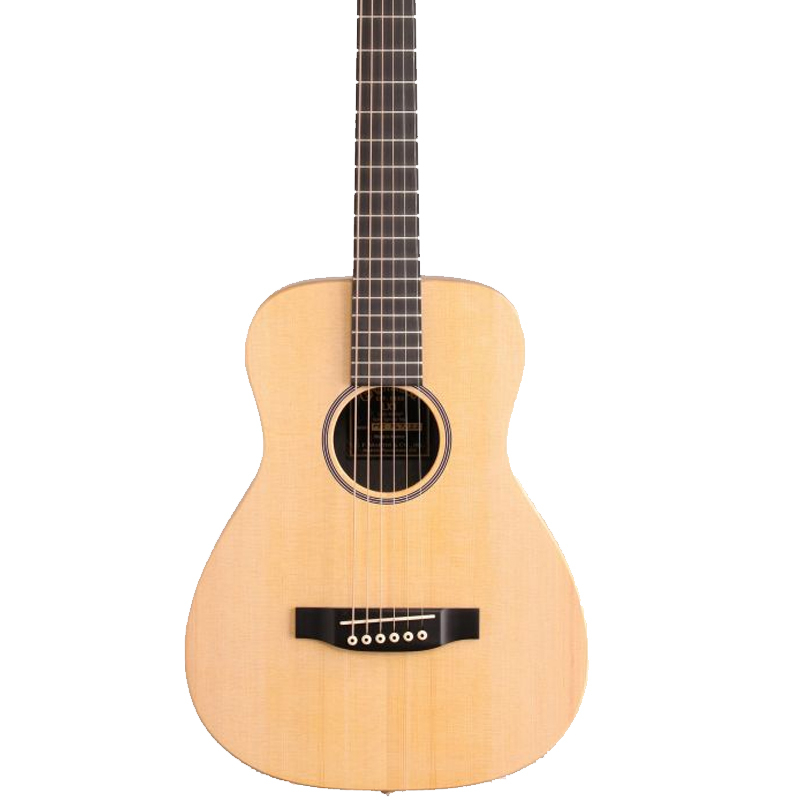
It’s not often a guitar can spawn an entire sub-genre, but the Martin LX1 did just that. After its launch nearly a decade ago, and with a little help from Ed Sheeran, the LX1 exploded in popularity and caused other brands to take note. The original is still regarded as the best though, and as a guitar for a learner, it comes exceptionally highly recommended.
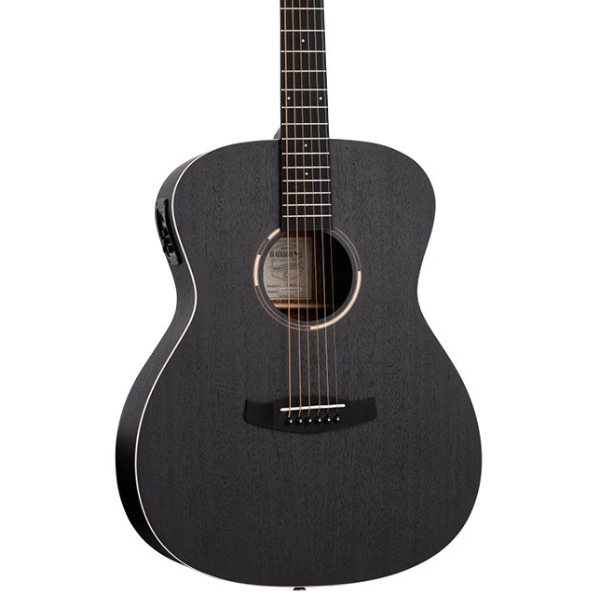
Selling bucketloads in the last few years, the Tanglewood TWBB-OE Blackbird is a fantastic acoustic to start honing your chops on. It’s incredible value for money, coming in well below many other offerings yet still provides excellent performance.
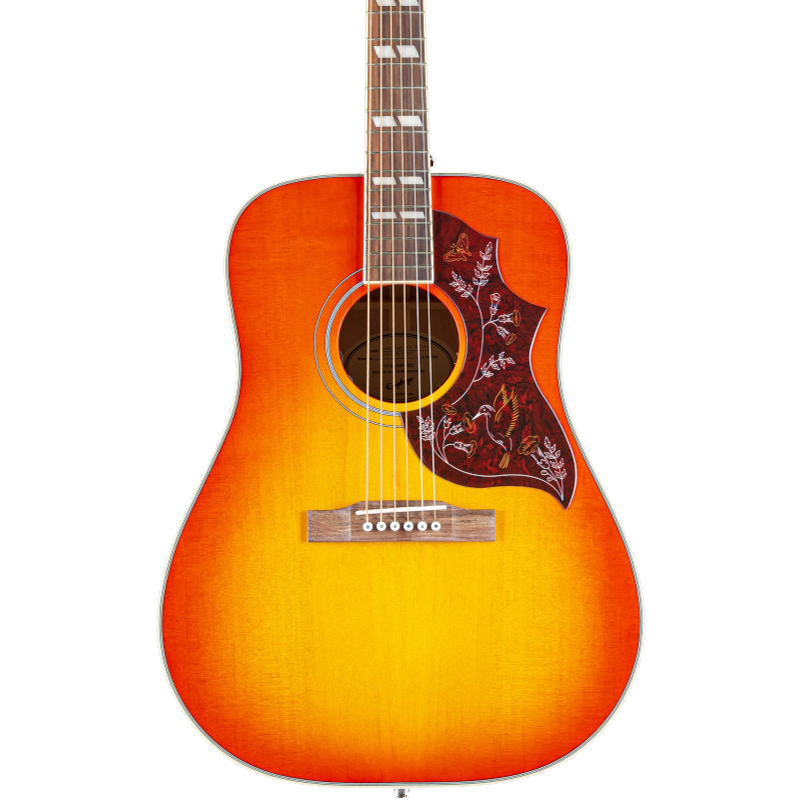
If you’ve heard of The Beatles, Oasis, Bob Dylan, or nearly any classic rock act from the last 60 years, then you’ll have heard a famous Hummingbird acoustic in action. The Epiphone Hummingbird Studio is as striking tonally as it is visually and would make a great choice for learning on.
Best overall
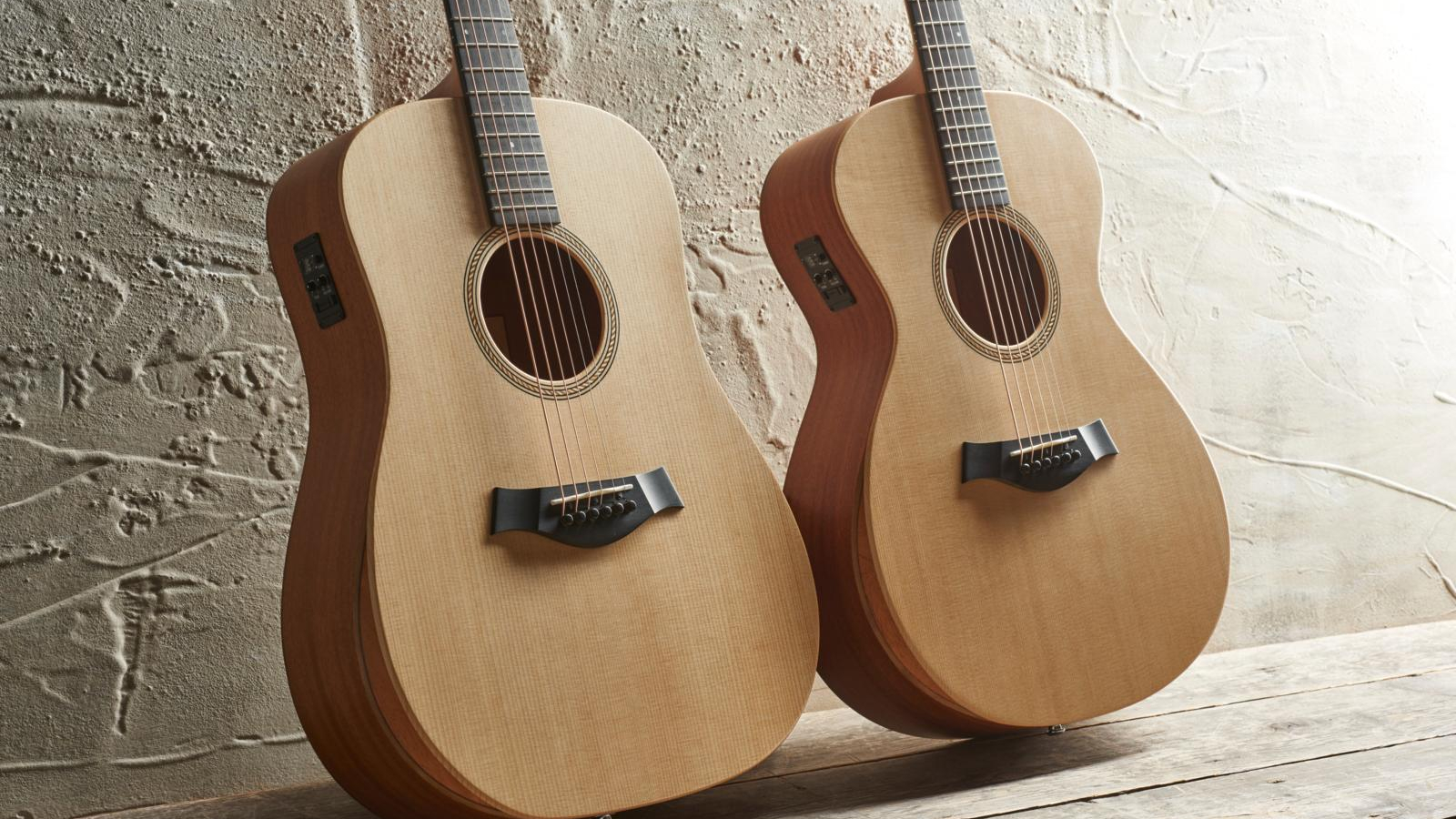
Specifications
Reasons to buy
Reasons to avoid
✅ Buy if you want a premium acoustic to start your journey: It's not cheap, but Taylor's Academy 10E will undoubtedly provide the best platform to launch your guitar journey and serve you well in the future too.
❌ Avoid if you're on a budget: Many of the guitars on this list are very budget friendly but this isn't one of them. Avoid if you're not sure that the guitar is 100% the instrument for you.
As one of the acoustic world’s ‘big two’, Taylor Guitars has a long track record of producing some of the highest quality, best sounding acoustic guitars around. Recently, however, it made a conscious decision to appeal to the beginner guitarist, and the Taylor Academy 10 is the culmination of this. While the price may put it slightly out of reach of anyone only half-heartedly interested in learning, for those who are committed this guitar represents incredible value.
Put simply, at this price bracket you will struggle to find a guitar which is as well made, which sounds as good, or is as easy to play. With the Academy 10, Taylor has produced the acoustic guitar we all wish we could have learned on. Although there is a left-handed electro-acoustic version – Taylor Academy 10E – Taylor doesn’t offer the pure acoustic in a left-handed variant. Lefties will have to bear the brunt of this and fork out a little more for the electro version.
Test | Results | Score |
|---|---|---|
Build | Super comfortable for beginners | ★★★★★ |
Tone | Excellent projection | ★★★★★ |
Performance | Slight lack of bass control live | ★★★★☆ |

"For me, the Academy Series represents a very clear vision, and in many ways, a dream beginner guitar, as well as potential trade-up for some existing players – one that can inspire and go the distance with a guitarist from bedroom to stage." Read our full Taylor Academy 10E review
Best on a budget
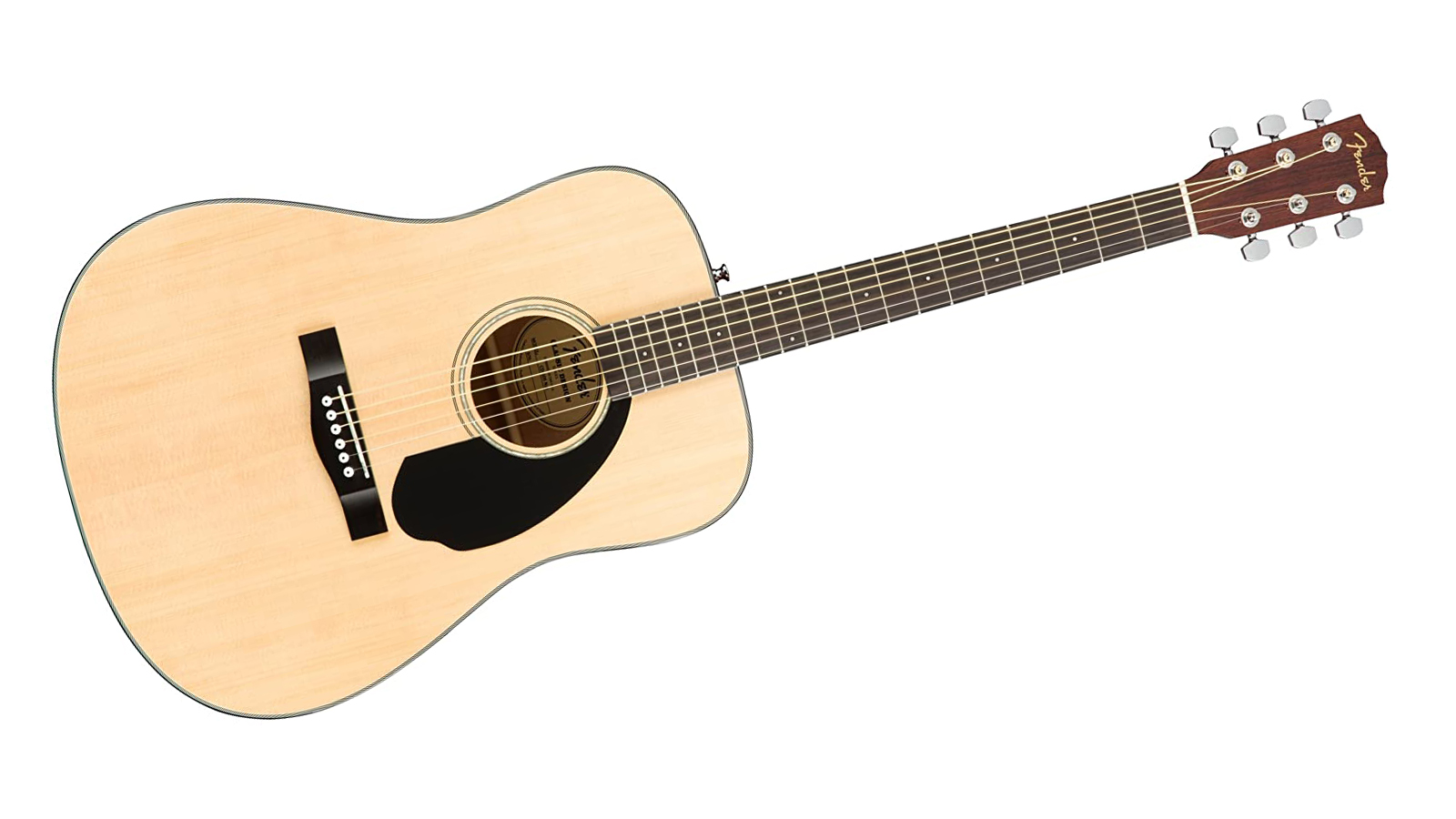
Specifications
Reasons to buy
Reasons to avoid
✅ Buy if you want a brilliant budget beginner acoustic: One of the most popular beginner guitars ever made, the CD-60S is a perfect marriage of great materials with an accessible price point.
❌ Avoid if you want something long-lasting: The build quality is fantastic, but you may find you want something with a little more tonal depth once you've developed your playing further.
If you’re uncertain exactly how much time and dedication you have to put into learning the acoustic guitar, don’t worry. It isn’t easy, and it does take time. At the very least, however, make sure you give yourself the best chance by buying an acoustic guitar that will see you through those first steps.
The Fender CD-60S is a great value, entry-level warm welcome of an acoustic guitar. We particularly like its neck, with its rolled fingerboard edges ensuring it is easy to pull off barre chords and the like. The solid spruce top is a nice feature that adds some depth of tone that beginner guitars are often devoid of. The large dreadnought body projects a boomy voice which will be pleasing as you start to make sense of those aforementioned barre chords.
However, the large body may be a potential detractor for the smaller-sized beginners out there, particularly the lower bout, which can be difficult to stretch over. Bear that in mind if you aren’t the biggest. However, this is a small gripe, and if the size fits, with the Fender CD-60S, you’ll have a very solid base on which to build.
Test | Results | Score |
|---|---|---|
Build | We love the comfortable neck | ★★★★★ |
Tone | More depth than most beginner acoustics | ★★★★★ |
Performance | A fantastic base on which to get started | ★★★★★ |

"Marrying a solid mahogany top with laminated mahogany on the back and sides, the CD-60S is a very attractive beginner's dreadnought with a bright, articulate and well-balanced voice." Read the full Fender CD-60S review
Best value acoustic
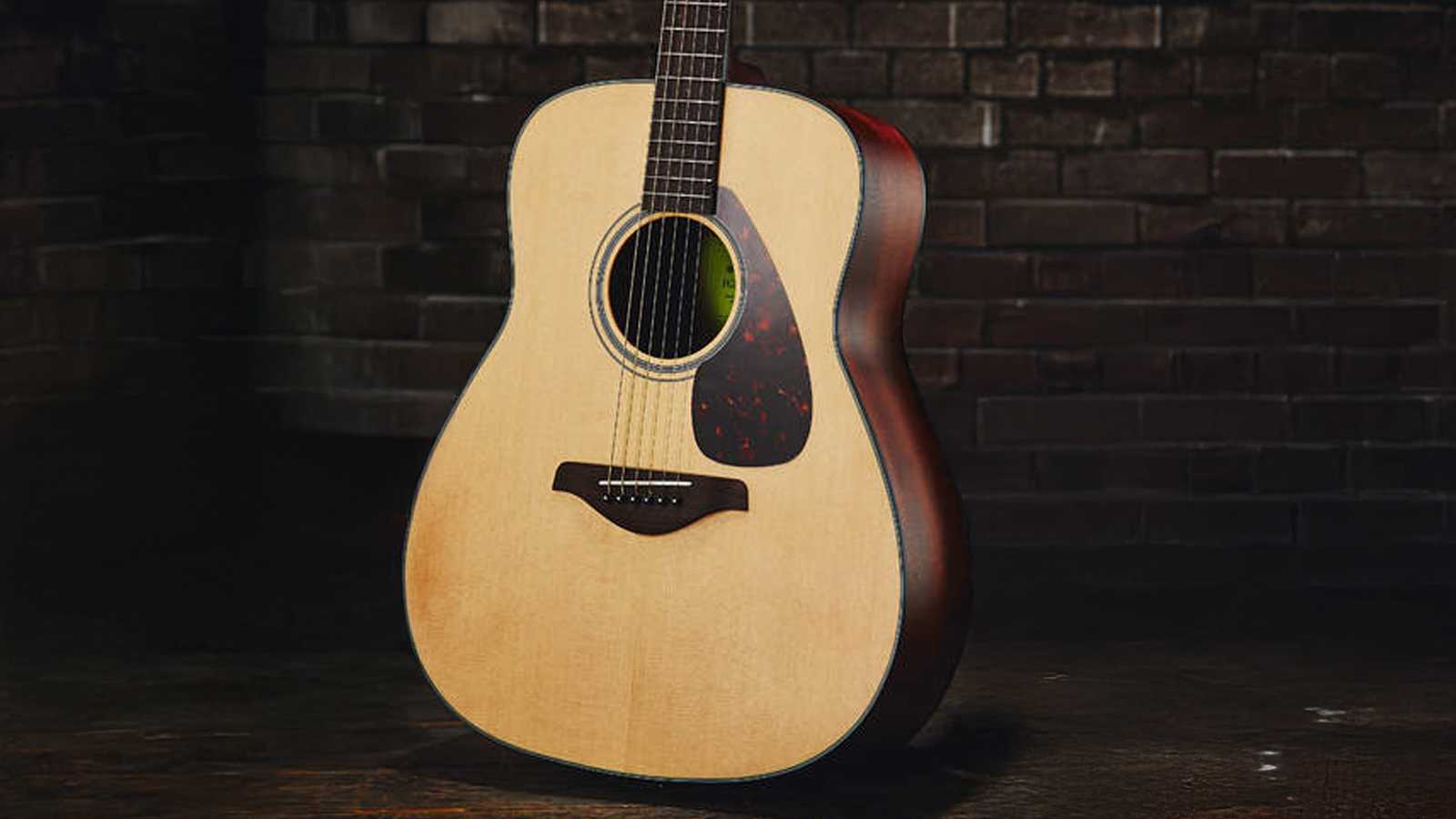
Specifications
Reasons to buy
Reasons to avoid
✅ Buy if you want value for your money: Despite being a beginner guitar, the FG800 features a solid top and scalloped bracing for a sound that far outweighs the price point.
❌ Avoid if you need a small guitar: It's a full-size dreadnought so for younger or smaller players this guitar will likely be too uncomfortable to play for an extended period of time.
The Yamaha FG800 has long been the go-to instrument for many players taking their first steps into the wide world of acoustic guitar – and when you consider what you get for the money it’s easy to see why.
The most surprising feature of the FG800 is the inclusion of a solid top – not something you usually find on a guitar at this price point. This allows the guitar to resonate freely, creating a fuller, warmer tone. Underneath the solid top lies Yamaha’s new scalloped bracing which results in plenty of volume and power. The large Dreadnought body accumulates all these features to produce a lovely, big tone.
The nato neck feels smooth and well-finished and we can’t think of many other necks a beginner will feel more comfortable on. We understand that the understated look may not set the world on fire, but it does have a classic charm that you simply won’t get bored of.
Test | Results | Score |
|---|---|---|
Build | Solid top at a fantastic price | ★★★★★ |
Tone | Plenty of volume and power | ★★★★★ |
Performance | Understated looks, but a great value package | ★★★★☆ |

"The FG800M is a typically classy, clean build and those of us who like our guitars to look a little less posh will find a friend here. For me, the FG800M is an impressive acoustic at a wallet-friendly price." Read the full Yamaha FG800M review
Best small bodied acoustic
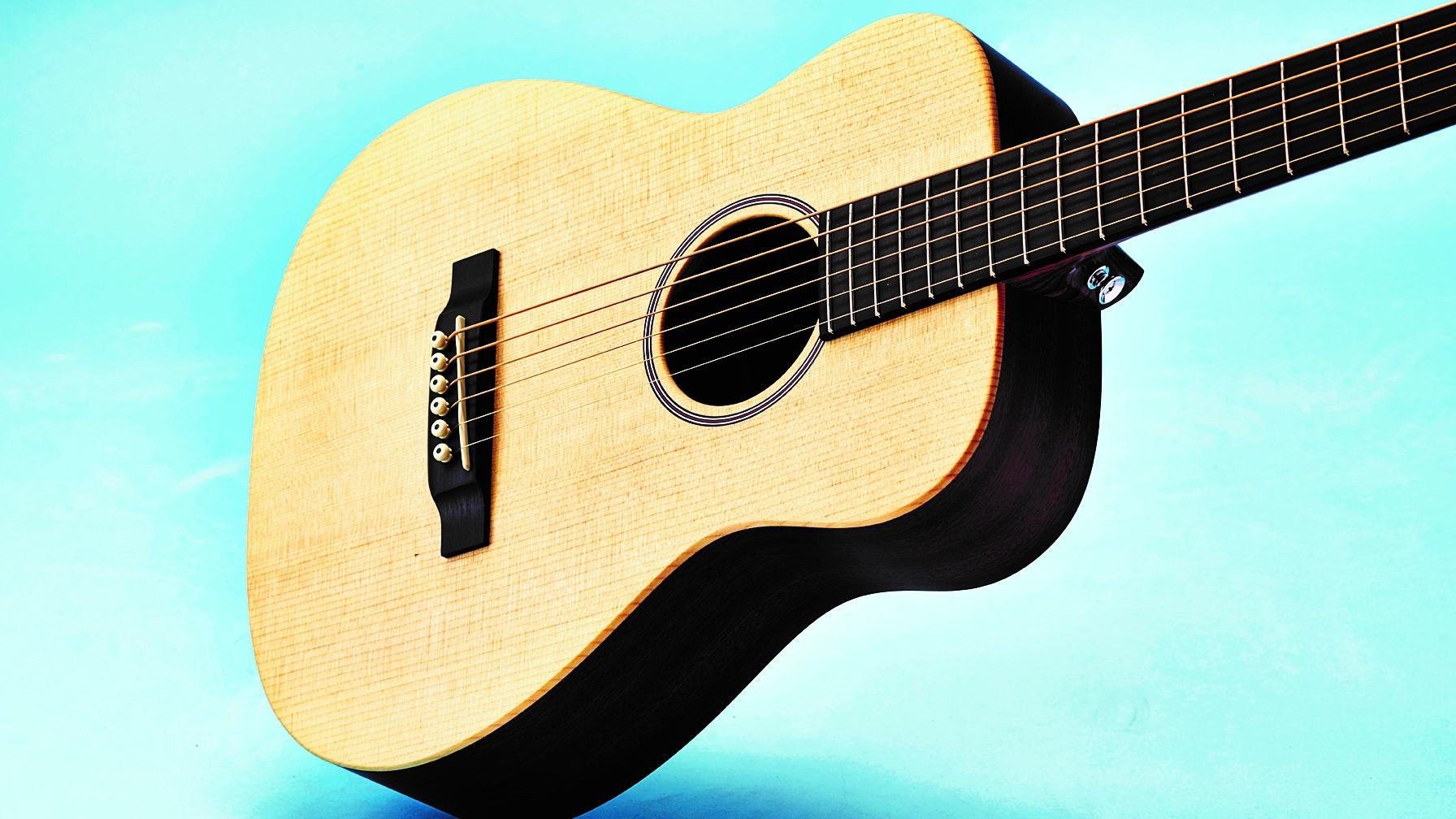
Specifications
Reasons to buy
Reasons to avoid
✅ Buy if you want a small beginner acoustic for younger players: The iconic Little Martin will be super comfortable for younger players or those of smaller stature thanks to the comfortable body size.
❌ Avoid if you want a loud acoustic: Due to that small body size, the Little Martin isn't the loudest acoustic here, so you may want to look at a dreadnought if you want more volume.
It’s not often a guitar can spawn an entire sub-genre, but the Martin LX1 did just that. After its launch nearly a decade ago, and with a little help from Ed Sheeran, the LX1 exploded in popularity and caused other brands to take note. The original is still regarded as the best though, and as a guitar for a learner, it comes exceptionally highly recommended.
Despite not being marketed as a learner’s guitar as such, the Martin LX1 is small enough to carry around in the included gig bag, ideal if you plan on taking it to your guitar lessons. The diminutive body is also a great option for those not comfortable with the size of a standard dreadnought.
However, with the smaller body, there is a slight compromise in volume and bass response but this is a minor detail and as a beginner, it probably isn’t going to ruin your day. There’s also an electro-acoustic version – the Martin LX1E – which is worth considering if you have future aspirations of performing.
Test | Results | Score |
|---|---|---|
Build | Functional and high quality | ★★★★★ |
Tone | Surprisingly big tone for such a small guitar | ★★★★★ |
Performance | An excellent small-bodied guitar for newcomers or smaller players | ★★★★★ |

"The Martin LX1E feels a bit utilitarian but packs a very endearing and classic steel-string punch, both acoustically and amplified." Read our full Martin LX1E review
Best electro acoustic
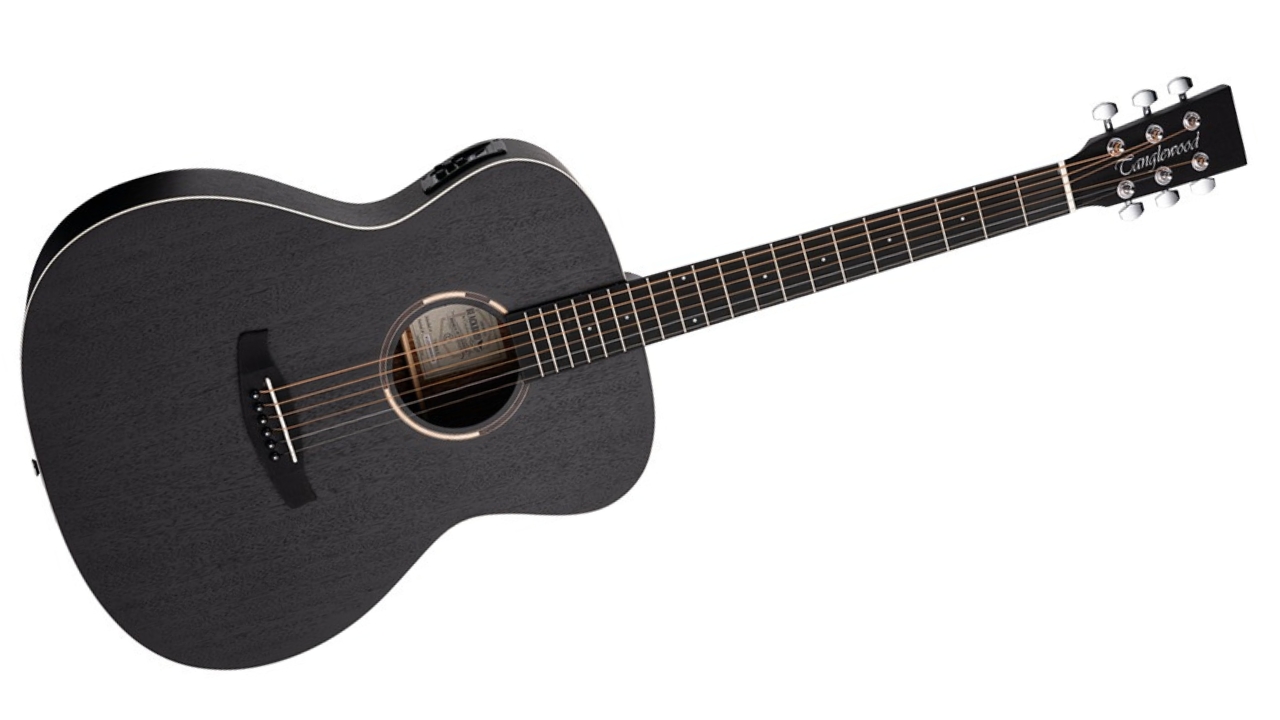
5. Tanglewood TWBB-OE Blackbird
Our expert review:
Specifications
Reasons to buy
Reasons to avoid
✅ Buy if you want a cheap electro-acoustic: With a four-band EQ the Blackbird is ultra-flexible when plugged in whilst the smaller body size makes it nice and playable for all.
❌ Avoid if you like a lot of bass: As it's a smaller, orchestra body size you don't quite get that same thumping low end that you would from a dreadnought acoustic.
Selling bucketloads in the last few years, the Tanglewood TWBB-OE Blackbird is a fantastic acoustic to start honing your chops on. It’s incredible value for money, coming in well below many other offerings yet still provides excellent performance.
We love the feel of the neck on the Blackbird, which offers an easy-playing feel that’s great for nailing those first chords and licks on. The action is nice and low out of the box, and overall, the feel of the guitar far exceeds the price point.
Of course, due to the smaller body size, there’s a lack of low-end compared to full-size instruments on this list. That said, we found it more than held its own in terms of volume when strumming hard. Onboard electronics mean you can play live and record directly with it, too. However, lefties have to make do with the non-electro version.
Test | Results | Score |
|---|---|---|
Build | Super smooth neck | ★★★★★ |
Tone | Plenty of volume and mid-range | ★★★★☆ |
Performance | We love having the electro option | ★★★★★ |
Best beginner dreadnought
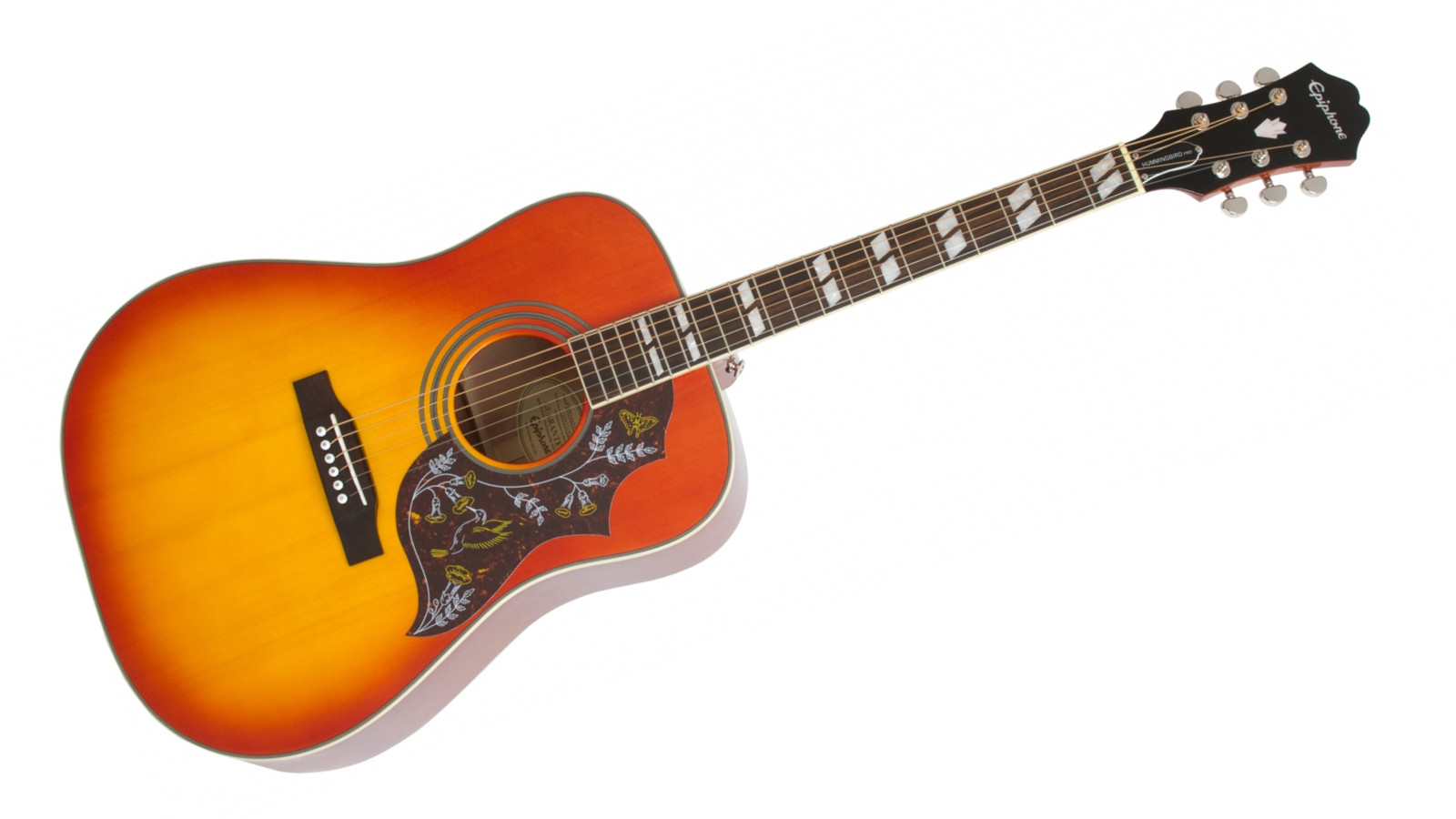
6. Epiphone Hummingbird Studio
Our expert review:
Specifications
Reasons to buy
Reasons to avoid
✅ Buy if you want a beautiful, full-size acoustic: This stunning instrument has got a huge voice and the body size to match, great for older learners or those looking for something a little distinctive.
❌ Avoid if you like traditional guitars: We love the looks, but we can also understand some might prefer a more traditional look for their first instrument.
If you’ve heard of The Beatles, Oasis, Bob Dylan, or nearly any classic rock act from the last 60 years, then you’ll have heard a famous Hummingbird acoustic in action. The Epiphone Hummingbird Studio is as striking tonally as it is visually and would make a great choice for learning on.
There’s more to this guitar than the fancy graphics and timeless vintage finish, though. The sound it produces is versatile and balanced, making it ideal for strummers and fingerpickers alike, while the small details like split parallelogram inlays and oversized headstock add up to make a bold visual statement.
The inbuilt Fishman electronics mean the Hummingbird Studio is future-proofed for any beginner looking to perform onstage or record with it. The electronics also make this guitar suitable for any intermediate players out there looking for a secondary beautiful acoustic to take to the local open mic nights. Although we love the ’Bird’s striking visual appeal, we realise it may put off the more subdued player.
Test | Results | Score |
|---|---|---|
Build | A beautifully-built beginner guitar | ★★★★★ |
Tone | Versatile and balanced | ★★★★★ |
Performance | An excellent guitar, despite the divisive look | ★★★★☆ |
More options...
Top: Solid Spruce | Neck: Nato | Fingerboard: Walnut | Frets: 20 | Electronics: Yamaha passive undersaddle pickup | Left-handed: No | Finish: Semi-Gloss Off-White
Who says beginner acoustic guitars need to be boring - certainly not Yamaha! The Storia range is the newest addition to Yamaha’s long list of budget-friendly instruments, and this one definitely stands out from the crowd.
Yamaha has designed the Storia I to not only be a great playing and sounding instrument but also to “elevate your décor.” We must admit, they’ve really nailed the brief and produced a guitar that will become the centrepiece of any room it’s in.
Not only does the Storia feature a solid spruce top, but the off-white finish against the mahogany back and sides is pretty striking. While the light-blue interior marries the two together to create a beautiful-looking guitar that sounds equally as good.
Read our full Yamaha Storia I review
Top: Spruce | Neck: Nato | Fingerboard: Rosewood | Frets: 18 | Electronics: N/A | Left-handed: No | Finish: Gloss
One of the staples of music rooms and classical guitar schools the world over, the Yamaha C40 II Classical has been the first guitar for many a guitar player. Nowadays, it’s the model for a beginner nylon string acoustic guitar, with many a pretender to its throne.
An acoustic with nylon strings is always a popular option for younger kids. Nylon strings are softer than steel and are less harsh on the fingertips. Although you will likely graduate to a steel-string guitar, a nylon-stringed acoustic is a great option as a stepping stone and is more likely to keep a child on board.
A rosewood fretboard delivers an excellent playing platform, with the flat radius ensuring you get into good habits straight away. The absence of fretboard markers can initially be confusing, but over time, it encourages players not to rely on them, which is a great habit to get into early on.
A spruce top gives this guitar a bright tone that’s very tonally balanced. Slap a decent set of strings on it and it will really sing, suiting an array of styles that will expand way beyond a classical repertoire.
Read our full Yamaha C40II review
Top: Solid Spruce | Neck: Mahogany | Fingerboard: Rosewood | Frets: 21 | Electronics: Fishman Sonicore | Left-handed: No | Finish: Sunburst
If you like the shape of a dreadnought acoustic, but find them all to look a bit generic, then the Gretsch G5024E Rancher may be just the guitar for you. You’ll notice immediately the unique shape of the soundhole, but look a bit deeper and you’ll see lots of small details which make this into an interesting guitar.
Things like binding on the body and gold-plated hardware add up to give this guitar a real sense of character. Tonally, it sits firmly in standard dreadnought territory, so it should prove versatile enough for most styles, and would be ideal for the learner who wants to try their hand at different genres of music.
Other great features include an onboard Fishman Presys III pickup which will allow you to amplify the guitar whilst the onboard tuner will help keep you playing at the correct pitch. If you are anxious about the slightly higher price, worry not, as the Gretsch G5024E Rancher will take you well into the intermediate levels of playing if you are committed enough.
Read or full Gretsch G5024E Rancher review
Glossary of terms
Action: The height of the strings above the fretboard. It impacts playability; lower action is generally easier for beginners.
Body: The large hollow part of the guitar that amplifies sound. It usually consists of a top, back, and sides.
Binding: A material that is added along the edges of the guitar’s body and neck for aesthetic purposes and to strengthen the joint between different woods.
Bracing: The internal wooden framework inside the body that provides shape and support.
Bridge: The part of the guitar that anchors the strings to the body. It also transmits the vibrations of the strings to the body.
Concert: A smaller body size than the dreadnought, the concert guitar offers a more balanced tone and is often easier to handle for players with smaller hands.
Cutaway: A design feature that carves out a portion of the body, allowing easier access to the upper frets. Common in many modern acoustic guitars.
Dreadnought: A popular body shape characterised by its large size and deep body, which produces a loud and powerful sound. Great for strumming and flatpicking.
Fretboard: The surface on the neck of the guitar where the frets are located. It’s where you press down strings to create notes.
Fretboard radius: The curvature of the fretboard. A flatter radius is often found on electric guitars, while a more pronounced radius is common on acoustic guitars, making it easier to play chords.
Frets: Metal strips embedded along the fretboard that divide it into pitches. Pressing the string down behind a fret shortens its vibrating length, producing a higher note.
Intonation: The accuracy of the pitch of each note played along the fretboard. Good intonation means that notes sound in tune, even when played higher up the neck.
Jumbo: An even larger body shape than the dreadnought, jumbo guitars have a wide soundboard that enhances volume and bass response.
Neck: The long, thin part of the guitar that extends from the body and holds the frets and fretboard.
Nut: A small piece located at the end of the fretboard that holds the strings in place above the fretboard and sets the string height.
Pickguard: A piece of plastic or other material located on the body of the guitar to protect it from scratches while playing.
Rosette: The decorative circle around the soundhole, often made from various materials and adds aesthetic appeal.
Saddle: The component that the strings rest on as they enter the bridge. It influences the guitar’s intonation and action.
Scale length: The distance from the nut to the saddle. It influences the guitar’s tone and playability.
Strings: Usually made of nylon (for classical guitars) or steel (for acoustic guitars), these are the wires that produce sound when plucked.
String gauge: The thickness of the guitar strings. Lighter gauge strings are easier to play, while heavier gauge strings produce a fuller sound but require more finger strength.
Tuning pegs: Also known as tuning machines or tuners, these are used to adjust the tension of the strings, therefore changing the pitch.
FAQs
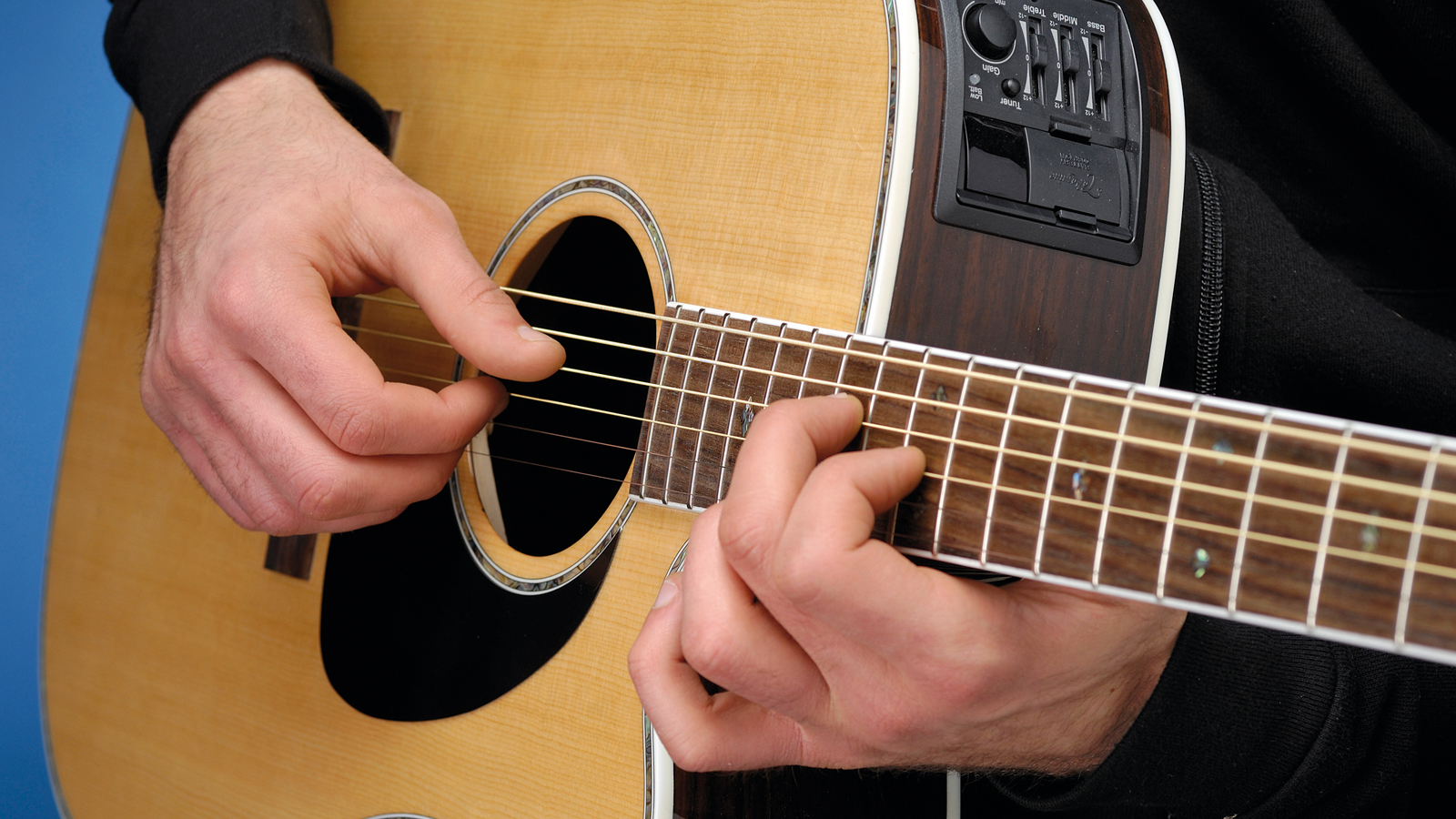
How to choose the best beginner acoustic guitar for you
MusicRadar's got your back
Although it may feel daunting, buying the best beginner acoustic guitar is more straightforward than many other instruments. For example, with beginner keyboards, electric guitars or DJ controllers, there is a number of variables to consider, but with the humble acoustic guitar, things are a lot simpler.
Sound-wise, acoustic guitars are famous for their projection and rich resonance. Therefore it's reasonable to expect any acoustic guitar - from the cheapest to the most expensive - to produce a warm sound with plenty of volume. The differences lie in what you want to do with them. When it comes to the best acoustic guitars for beginners, factors like the shape of the body, the type of woods used and brand, all affect how the instrument will sound.
What acoustic guitar size is right for a beginner?
As you'd expect, acoustic guitars come in myriad shapes and sizes. So, let's quickly break down the most common.
Generally speaking, the bigger the guitar, the bigger the sound. But obviously, larger acoustics do have some problems for kids starting out. For example, the dreadnought is arguably the most popular and common of the acoustic guitar shapes. Its large frame produces a massive tone with plenty of low-end and depth. Although this guitar may be commonplace, we would avoid it for young players. Its large size can make it uncomfortable for many youngsters. Likewise, the jumbo - typically the largest of the acoustic world - is ginormous and can be too big for little arms to get around.
Smaller sizes such as concert, grand auditorium or folk offer a more effortless playing experience. However, you will lose a little bit of tone - not something that's hugely important at this early stage.
What kind of wood is best for a beginner acoustic?
While it's true that the wood used on acoustic guitars gives the instrument its distinctive tonal characteristics, it's not always noticeable on beginner guitars. At this price point, you'll usually find fully laminated guitars rather than the more premium solid wood option.
That said, we can give you some general things to look out for. You'll find a lot of guitars go for the tried and true formula of spruce and mahogany. This combination gives a very balanced and sweet tone. In contrast, an all-mahogany guitar - top, back and side - is going to result in a darker, more mellow sound.
Perhaps you are seeking a bright tone, in that case, you are best opting for an acoustic guitar with maple back and sides. Not only does this look gorgeous, but the maple gives the guitar more presence in the top-end.
Do I need a pickup on my beginner acoustic guitar?
You might also want to consider whether you want to perform using your guitar or perhaps record with it. If so then it's worth looking for an acoustic guitar with onboard electronics, as they'll enable you to plug it into an amp or recorder in the same way you can an electric guitar.
Acoustic guitar pickups, simply put, are devices which translate the sound of your acoustic guitar into an electrical signal. This signal goes through your guitar cable and then into any of the best acoustic amps or a PA speaker. There's more science to it than that, but we won't go into it in too much depth here.
What else should I know about buying a beginner acoustic guitar?
An important factor in learning any instrument is how much you enjoy the learning process. Therefore, it is vital that the guitar you choose as your learning partner is one you enjoy playing. We've seen and heard countless examples of people who give up because they found it too challenging, but as players, we know it's because their beginner guitar is often not up to the task.
If you're committed to learning, it makes sense in the long run not to choose your first guitar with price as the only criteria. That said, we know it's not as simple as that, so we've got suggestions here from all ends of the spectrum.
Are steel or nylon strings better for beginners?
The two main string options you’ll face when searching for a beginner acoustic guitar will be either steel or nylon.
Traditionally kept for classical or flamenco guitar, nylon strings have been a perennial favourite of beginners starting on the acoustic. This is because nylon strings are a lot softer than their metal counterparts, meaning they can be gentler on your fingertips whilst you develop calluses. This has made nylon strings a popular choice amongst younger beginners. However, this is not to say they won’t sting at all because, as a beginner, your fingertips will be a lot more sensitive and it takes time to dull that sensitivity.
Your other option is a steel-string acoustic. Sonically, steel strings are a lot more common and popular. If you aren’t specifically playing classical or flamenco, steel strings will more likely suit your preferred tastes in music too. Although they can sting a beginner’s fingertips quite quickly, they will get that ‘teething’ stage over with faster. Also, a nylon string acoustic is often a stepping stone to a steel string, so if you want to cut out the middleman, go for a steel string option.
Should I take lessons?
Picking up a new beginner acoustic is useless unless you know how to play it! Some people are able to pick things up by ear, or have someone in the house to show them the ropes. If neither of the above applies, we would heartily recommend taking lessons.
Face to face lessons are a great way to build a bond with a teacher and develop your skills in a hands-on way, but if you want to quickly understand basic guitar techniques, learn from the comfort of your home and don't have a massive budget, online lessons are a great route to take. You can learn more and discover our favorites in this guide to the best online guitar lessons.
You can currently make savings on some of those platforms using the links below, too.
Fender Play: 50% off an annual subscription
Sorted a free trial but now you want to continue getting all the benefits of Fender Play lessons beyond your trial? For MusicRadar readers, Fender is offering 50% off an annual plan, dropping the price from $99.99 to just $49.99. Just add the code musicradar50 at checkout.
Guitar Tricks: Get your first month for just $1!
Enjoy your first full access month of Guitar Tricks for just a single dollar using this exclusive MusicRadar link. Guitar Tricks delivers loads of great content for beginners, while intermediate and pro players can dive into over 11,000 expert videos and lessons across the site.
TrueFire: Save 30% on new subscriptions and more
Right now, TrueFire is offering MusicRadar readers 30% off their first or next TrueFire purchase. This promotion includes All Access subscriptions and all courses. Just add the code MRTF30 at checkout to claim your discount.
How we test beginner acoustic guitars

Acoustic guitars are some of the most subjective instruments out there. Every player has their own set of preferences that they look for in an acoustic guitar - but there are a few key criteria every beginner acoustic guitar should meet before we recommend it to our readers.
It's crucially important that a beginner acoustic guitar is built well, so the first thing we look at is the overall build quality of the instrument. We need to make sure any acoustic guitar we recommend is sturdy and reliable, and won't let you down. We make sure it's all put together properly, and that the moving parts move, and the parts that aren't mean to move, don't.
We then check the setup, and the level of finish of the guitar. We look at the action (the vertical distance between the strings and the fingerboard), and also the fretwork - making sure there are no dead spots or sharp fret ends. Beginner acoustic guitars, being on the cheaper end of the scale, can sometimes suffer from less thorough quality control checks from the manufacturer, so we like to make sure that everything is as it should be.
We then test the playability and sound. We check how comfortable the neck and body are, how the neck profile feels in our hand and how the fingerboard radius feels when playing. We'll play a variation of different styles including chord strumming and fingerpicking to come to our conclusions.
Find out more about how we test music gear and services at MusicRadar.
Why you can trust us

✔️More than 9,500 reviews on-site
✔️Over 17 years of product testing
✔️ 2.9 million monthly users globally
With more than 17 years of experience, MusicRadar is the premier music-making website in the world. Run by musicians for musicians, we offer expertly written gear round-ups and high-quality, authoritative reviews by an extensive team of highly experienced industry professionals.
We also interview world-renowned musicians and stars about their creative processes and the nuts and bolts of their gear and technique. This gives fans an insight into the actual craft of music-making that no other music website can.
But that's not all. We also provide excellent tuition, from bite-sized tips to advanced techniques and guidance from recognised musicians.
As well as delivering high quality written reviews and features, we also produce a wealth of video content on YouTube. MusicRadarTV is where you'll find all of our access-all-areas interviews, hot gear demos and exclusive video lessons.
Read more
- Best electric guitars for beginners: start playing today
- Meet the best cheap acoustic guitars
- Freshen up your tone with the best acoustic guitar strings
Want all the hottest music and gear news, reviews, deals, features and more, direct to your inbox? Sign up here.
Chris Corfield is a journalist with over 12 years of experience writing for some of the music world's biggest brands including Orange Amplification, MusicRadar, Guitar World, Total Guitar and Dawsons Music. Chris loves getting nerdy about everything from guitar and bass gear, to synths, microphones, DJ gear and music production hardware.
- Matt McCrackenJunior Deals Writer
- Ross Holder
